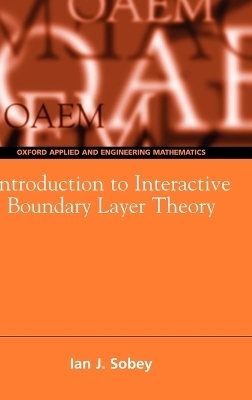
Introduction to Interactive Boundary Layer Theory
Seiten
2000
Oxford University Press (Verlag)
978-0-19-850675-1 (ISBN)
Oxford University Press (Verlag)
978-0-19-850675-1 (ISBN)
Presents an account of the development of laminar boundary layer theory as a historical study. This book includes a description of the application of the ideas of triple deck theory to flow past a plate, to separation from a cylinder and to flow in channels. It is intended to provide a graduate level teaching resource.
One of the major achievements in fluid mechanics in the last quarter of the twentieth century has been the development of an asymptotic description of perturbations to boundary layers known generally as 'triple deck theory'. These developments have had a major impact on our understanding of laminar fluid flow, particularly laminar separation. It is also true that the theory rests on three quarters of a century of development of boundary layer theory which involves analysis, experimentation and computation. All these parts go together, and to understand the triple deck it is necessary to understand which problems the triple deck resolves and which computational techniques have been applied. This book presents a unified account of the development of laminar boundary layer theory as a historical study together with a description of the application of the ideas of triple deck theory to flow past a plate, to separation from a cylinder and to flow in channels. The book is intended to provide a graduate level teaching resource as well as a mathematically oriented account for a general reader in applied mathematics, engineering, physics or scientific computation.
One of the major achievements in fluid mechanics in the last quarter of the twentieth century has been the development of an asymptotic description of perturbations to boundary layers known generally as 'triple deck theory'. These developments have had a major impact on our understanding of laminar fluid flow, particularly laminar separation. It is also true that the theory rests on three quarters of a century of development of boundary layer theory which involves analysis, experimentation and computation. All these parts go together, and to understand the triple deck it is necessary to understand which problems the triple deck resolves and which computational techniques have been applied. This book presents a unified account of the development of laminar boundary layer theory as a historical study together with a description of the application of the ideas of triple deck theory to flow past a plate, to separation from a cylinder and to flow in channels. The book is intended to provide a graduate level teaching resource as well as a mathematically oriented account for a general reader in applied mathematics, engineering, physics or scientific computation.
| Erscheint lt. Verlag | 30.11.2000 |
|---|---|
| Reihe/Serie | Oxford Texts in Applied and Engineering Mathematics |
| Zusatzinfo | numerous line figures |
| Verlagsort | Oxford |
| Sprache | englisch |
| Maße | 161 x 241 mm |
| Gewicht | 639 g |
| Themenwelt | Mathematik / Informatik ► Mathematik ► Analysis |
| Mathematik / Informatik ► Mathematik ► Angewandte Mathematik | |
| Mathematik / Informatik ► Mathematik ► Geschichte der Mathematik | |
| Naturwissenschaften ► Physik / Astronomie ► Strömungsmechanik | |
| Technik ► Maschinenbau | |
| ISBN-10 | 0-19-850675-9 / 0198506759 |
| ISBN-13 | 978-0-19-850675-1 / 9780198506751 |
| Zustand | Neuware |
| Haben Sie eine Frage zum Produkt? |
Mehr entdecken
aus dem Bereich
aus dem Bereich
Buch | Softcover (2024)
De Gruyter Oldenbourg (Verlag)
59,95 €


